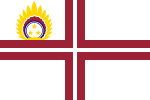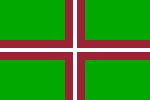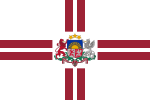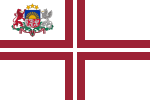Flag of Latvia
| Flag of Latvia | |
|---|---|
 |
|
| Vexillological symbol : |
|
| Aspect ratio: | 1: 2 |
| Officially accepted: | First reintroduced: November 18, 1918 : February 27, 1990 |
The flag of Latvia is the national and commercial flag ( Latvian Latvijas valsts un tirdzniecības karogs ) of Latvia .
Meaning and structure
The flag shows two horizontal red stripes that are separated by a white stripe in the middle. The red stripes are twice as wide as the middle white stripe.
The first Prime Minister of Latvia, Kārlis Ulmanis , who was also the last president before the Soviet invasion in 1940, described the meaning of colors as follows: White is the symbol of purity and justice. The red symbolizes the blood that was shed to achieve independence. Noteworthy is the unusual ruby color ( Pantone -Farbcode 1807C - CMYK 0; 68; 66; 35 - sRGB 167; 53; 57 - Hex # A73539), as "Lettischrot" ( English Latvian Red was designated). It is said to come from berries which the Latvians are said to have used to color the flag.
Thus, the Latvian flag differs in three things from the red-white-red Austrian flag :
- the ratio of the width of the stripes is 2: 1: 2 (for the Austrian 1: 1: 1)
- the red is not heraldic (high) red, but Latvian red
- the ratio of width to length is 1: 2 (the Austrian 2: 3).
history
After the defeat in 1209, King Visvaldis of Jersika , also called Latvia ( terram, quae Lettia dicitur ), was forced to accept the peace dictate of Bishop Albert I of Livonia . He had to give his hereditary kingdom to the bishop and only got part of it back as a fief. In this case three flags were used as symbols of investment. The first mentions of a red-white-red banner come from the year 1279. In the Livonian rhyming chronicle it says in the ( Middle High German ) verses 9219 to 9233 ( the verses describing the flag were highlighted here ):
“From Wenden what zû Rîge komen
zûr lantwer , when I heard hân,
a brother and wol a hundred man: he was
that mêre kunt done.
the quâmen hovelîchen represent
with a banier rôtgevar
that what with knowledge through
cut would have to wendish siten.
Wenden is a burc known
by the banier wart,
and is located in Letten lant , that
the vrowen rîtens maintain
after the site as the one.
I would like to say that
the banier is the Latvians . "
The Latvian flag is one of the oldest flags in the world that is still in use today. The source was discovered by Jekab's Lautenbahs-Jusmins and popularized as the Latvian national flag by students at Tartu University in 1870. In May 1917, the Latvian artist Ansis Cīrulis (1883–1942) referred to the Christianization of Latvia by crusaders described in the rhyming chronicle and designed today's flag of Latvia, which was first adopted on November 18, 1918.
On December 17, 1918, during the Latvian War of Independence , Communists briefly proclaimed an independent Latvian Soviet Socialist Republic ( LSPR). It was not until 1920 that Latvia's democratic troops, with German and Polish help, were able to defeat the communists. The LSPR used a red flag with the gold initials in the canton .
Formally, a decree on the national flag was passed on June 21, 1921. On February 15, 1922, the Latvian Assembly passed a flag law and on January 23, 1923 it was signed by the President. In addition, the flags of the President, the Prime Minister and other military and civil flags were set, a total of 17 different ones.
In 1940 the Soviet Union annexed the Baltic states . As a Soviet republic, Latvia initially received a flag corresponding to that of the Soviet Union with its initials. In 1953, the design of all the flags of the Soviet republics was changed and Latvia was given a Soviet flag with a white and blue wave pattern, which was very similar to the flag of the Estonian Soviet Socialist Republic. However, the wave crests of the Estonian flag were pointed and the Latvian flag was round. In addition, the Latvian pattern was on the lower edge, while the Estonian had another red field below. The front of the flag also featured a hammer-and-sickle symbol and a red star. The old flag of Latvia was still used by Latvians in exile.
With independence, the Soviet laws that made the flag of Latvia illegal were annulled and the Latvian flag was again adopted by parliament on February 27, 1990.
1: 2 ? Flag of the Duchy of Courland and Semigallia (1562–1795)

1: 2 ? Flag of Latvia (1918-1940)

1: 2 ? Flag of the first Latvian SSR (1918-1920)

1: 2
 flag of the Second Latvian SSR (1940-1953)
flag of the Second Latvian SSR (1940-1953)
1: 2 ? Flag of the Second Latvian SSR (1953-1990)


1: 2 ? Back of the flag of the Second Latvian SSR


Flag days
The Latvian flag will be officially set on the following days:
- March 25 *: Memorial day for the victims of communist terror (2nd mass deportation 1949)
- May 1: Constitution of the Constituent Assembly of the Republic of Latvia 1920; Labor Day
- May 4: The independence of the Republic of Latvia was declared again in 1990
- June 14 *: Remembrance day for the victims of communist terror (1st mass deportation 1941)
- June 17 *: Occupation of the Republic of Latvia by the Soviet Union in 1940
- July 4th *: Memorial day for the victims of the genocide of the Jews during the Nazi occupation in 1941
- November 11: Memorial Day for the Latvian Freedom Fighters 1919 ( Lāčplēsis Day )
- November 18: Proclamation of the first Republic of Latvia in 1918
- 1st Sunday in December *: Memorial day for the victims of the genocide of the Latvian people by the totalitarian communist Soviet regime
* Mourning flags with black ribbon
On these days all public buildings (schools, government and administration buildings etc.) and residential buildings must be flagged; Failure to flag or incorrectly flagged may U. be punished with fines. This will be the case on other festive and commemorative days, for example the Independence Day of Lithuania (February 16) and Estonia (February 24), the day the constitutional act for the restoration of the Republic of Latvia was passed (August 21), New Year, Easter, Pentecost, Mother's Day etc. Flagging recommended.
On election days for Parliament (Saeima) and the European Parliament , during local elections and referendums , the buildings in which polling stations are set up are flagged.
Subnational flags
The municipalities of Latvia have their own flags. As is often the case with municipal flags, the municipal coat of arms is often depicted on the flag. The often used gray color is unusual. Here are a few examples.
Military flags
 ? 2: 3, Naval War Flag of the Republic of Latvia
? 2: 3, Naval War Flag of the Republic of Latvia
Flags of ethnic groups and other ethnic groups
The Livs use a horizontal tricolor, which has the same structure as the Latvian national flag. The colors of the Livonian flag are green-white-blue; Blue stands for the sea, white for the sand of the coast and green for the forests. It was presented at the first Livonian gathering on April 2nd, 1923 and was first set on November 18th at the Livonian festival in Mazirbe ( Irē ).
Part of the resident population of Latvia does not have Latvian citizenship. This mostly Russian-speaking group has Latvian passports in a purple color. This was picked up in a campaign in 2005 and included in a flag that corresponds to the structure of the Latvian national flag.
Other flags of Latvia
literature
- Kursemes Wahrds (Kurlands Wort), No. 134, Thursday, June 16, 1921 (PDF; 1.1 MB) Report on the parliamentary decision of the previous day
Web links
- Flags of the World - Latvia (English)
Individual evidence
- ^ Cleveland H. Smith and Gertrude R. Taylor: Flags of All Nations. Thomas Y. Crowell Co., New York 1946, p. 101
- ↑ Subjectio regis Wsewolodo et donatio urbium Berzilia, Autorp, Zcessowe etc. ecclesiae S. Mariae Rigensis et investitura harum urbium data eidem from episcopo post fidelitatem factam. Anno 1209 . LGU., I.2.
- ^ The Flag Bulletin: VIII: 3, Flag Research Center, Box 580, Winchester, Mass 01890 USA, Summer 1969, ISSN 0015-3370
- ↑ Latvian State Flag Act of November 17, 2009, Section 7 (Latvijas valsts karoga likums, 7. pants http://www.likumi.lv/doc.php?id=200642 )
- ↑ Latvian State Flag Act, Section 9
- ↑ Flags of the World - Livonian People (Latvia)
- ^ Flags of the World - Russians in Latvia




























